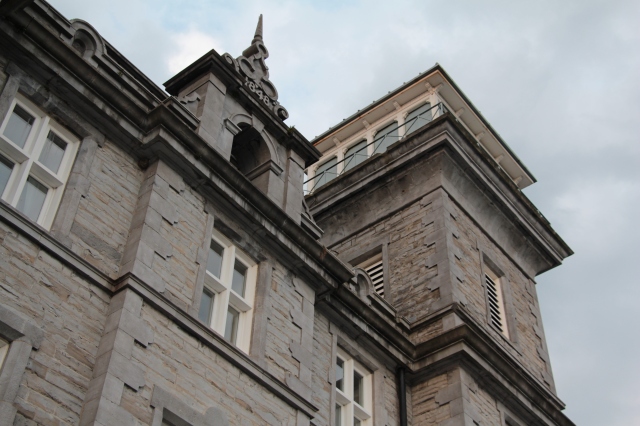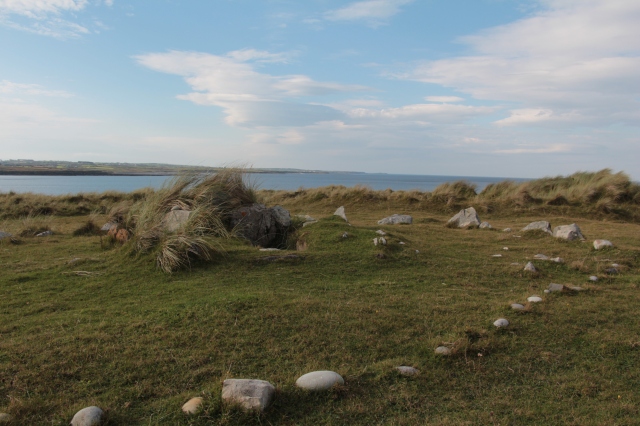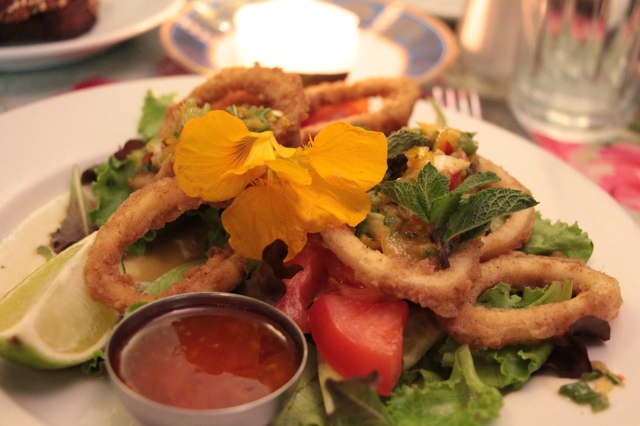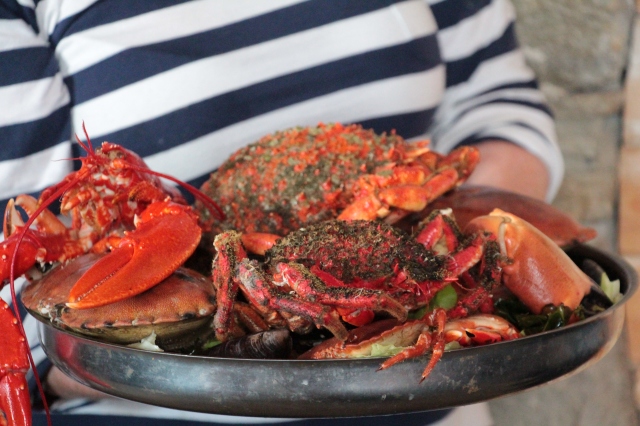Somewhere named Sligo

It’s the palm trees that get you.
There are some things you expect to see in Ireland: rolling green hills, fields of sheep, rainbows with leprechauns at the end pouring pints of Guinness. But not palm trees.
And yet, in a little pocket of the northwest known as Sligo, you’ll find them. You’ll also find other things that seem out-of-place for the Emerald Isle, like a Kiwi surf instructor who came up from down under because the waves are just better in Ireland. And ancient sea fossils embedded in the sand, seemingly so many of them that you can barely put a foot down without landing on a piece of marine life that’s millions of years old. And stand-up paddleboard lessons, and chefs dedicated to organic foods, and musicians jamming in pubs and on the streets as evening falls (okay, that last one is totally what you expect to find in Ireland).
And that’s the reason behind a recent tourism campaign for this region, called #SligoWhoKnew. Because, really, Sligo County embodies everything you didn’t know about Ireland, and then some.
I arrived in Sligo feeling a bit disoriented. We had come in (“we” being me and my coworker Stacey) on a red-eye flight that saw us landing in Dublin looking and feeling like we were extras in a bad zombie flick. Several hours on a bus later, we arrived in Sligo Town, and somehow, despite reaching hour 24 of being awake, I suddenly felt very alive. (The whipping winds of a North Atlantic sea in September will do that to you.)
But it was more than the brisk air. There’s something almost magical about Ireland. It’s like the country breathes life into you. And that night and in the days ahead, we were teased with twists on traditional Irish culture, typical of the Sligo quirk we’d soon come to love.
Asylums and dreams
We spent our first night at the Clarion Hotel Sligo, a beautiful, old stone building—the kind of fairy tale-like architecture you expect to find in Ireland. But it also holds an unexpected past: from the mid 1800s to 1992, the property was an asylum, specifically the St. Columbas Lunatic Asylum. It closed down in 1992 and remained abandoned for 10 years until the Clarion stepped in and bought the property. Information on the history of the asylum is noticeably sparse, even on the hotel’s own website, but we did hear whispered rumours of ghosts that roam the hallways and there’s an unmistakable eeriness hanging over the place (I am willing to admit that also may have just been the power of suggestion). But don’t get me wrong—the building’s mysterious past is actually part of the charm, and part of what makes it so appropriate for a place like Sligo. Because, well, see below.
Vikings and vampires
Ireland is the kind of place that overwhelms you with history. From the dramatic ancient tales of vikings to the horrors of the Great Famine to the still-fresh memories of The Troubles, there is so much history packed into that little island. But in Sligo, as we chatted with locals and did a walking tour with maritime archaeologist Auriel Robinson of Seatrails (side note: coolest job title ever), we realized that the region’s history holds many secrets. Like how three ships from the ill-fated Spanish Armada remain sunken at Streedagh Strand, along the north coast of Sligo. Or how the rocks at Streedagh are littered with ancient fossils of sea life from millions of years ago. Or how wedge tombs dating back thousands of years can still be found scattered throughout the countryside, most of them facing west toward the setting sun over the cold, grey waters of the Atlantic.
Or like how Sligo is believed to be the home of the vampire—specifically, the home of Dracula. Researchers have suggested that Bram Stoker got some of his inspiration for Dracula from his mother’s tales of living in Sligo during a cholera epidemic, when bodies were tossed into mass graves, sometimes some still living along with the dead. Sligo Tourism even put on a Bram Stoker Experience event this year for Halloween to honour the connection.
Seafood and seaweed
Dining out in Ireland means battered fish, beef stews, potatoes and beer, right? Yes, but it’s not all there is, and I’m not just talking about fine dining restaurants in downtown Dublin. Even in tiny towns throughout Sligo, you can find twists on the traditional fare.
Our first night, we ate dinner by the water at Shells Cafe in Strandhill. A group of people were holding an impromptu jam session at a picnic table outside the door, while the sun set into the Atlantic just a few steps away. Meanwhile, inside, the cafe was warm and cozy, with an eclectic decor that makes you feel like you’re not sitting in a restaurant, but in a good friend’s kitchen. Plates of battered fresh fish filled our tables, paired with pretty salads and slices of homemade bread, all served up by owners Myles and Jane Lamberth, a couple who are “at home welcoming all the regulars into Shells and putting the world to rest over copious amounts of tea,” according to their website. (How can you not love a place with that as its mission?) Everything on the menu is prepared in-house, the herbs are grown in a garden in the back, the coffee is organic and fair trade, and the ingredients are locally sourced whenever possible.
The next afternoon, we sampled Eithna’s by the Sea in Mullaghmore, where the fish is fresh and all the produce is locally sourced and organic. Eithna O’Sullivan’s menu changes with the seasons, and is always unique, with treats like carrageen panna cotta and meringue with berries and sea spaghetti—and if you like the food (which, if you’re a fan of seafood, you will), the restaurant includes a store where patrons can buy ocean-inspired goodies to take home, like homemade seaweed pesto and dried carrageen moss (said to be the ultimate cure for flu season). What’s more is Eithna’s offers classes on marine life and Mullaghmore’s heritage, and hosts seminars on maintaining a healthy diet. This is a restaurant that’s healthy, delicious, eco-conscious and educational.
Music and martinis
Of course, as is tradition in Ireland, we headed out in Sligo Town one night for an evening of live music and beer—really, the quintessential Irish experience. Except, rather than the pub scene you’d expect, we landed in a trendy lounge that featured cocktails and platters of gourmet appetizers (sadly, I’ve since heard that the lounge, Source Sligo, has closed indefinitely). Unexpectedly stylish and ridiculously busy, the place was packed with people and a line-up of wonderfully talented musicians, including the emcee for the night, Miles Graham (for whom I am now a slightly overly enthusiastic fan—so even though Source Sligo is no longer open, I’m still writing about it just so I can post this clip of Miles performing that night). You can also listen to the full song here.
So you could say Sligo is something like Bali meets Transylvania with a dash of California: romantic, dark, mysterious, mellow and almost tropical in mood (if not temperature). And yet, it is also like none of those places. It is pure Ireland—just not the Ireland you thought you knew.
Sligo, who knew indeed.
I travelled to Sligo as part of a fam trip for the Wild Atlantic Way coastal drive with Failte Ireland and Tourism Ireland; however, all views expressed are entirely my own.





Great stuff Tammy, you’ve captured all the best bits 🙂
And then just like that, I’m checking flights to Ireland again.
XO
Reblogged this on Belfield League 2013 newsletter.
Glad u enjoyed your stay in our little corner of the world 🙂
Beautiful little town. Hope the tailor shop that was, is still there. McKinney.
It’s not called ‘land of hearts desire’for no reason!
Yes, and I forgot to even mention that! Totally worthy of the moniker.
That’s my home SLIGO, im Soooo blessed.
You are VERY blessed, Paula! It’s a really lovely place.
Reblogged this on U stóp Benbulbena and commented:
It’s great to know you like your trip to our part of Ireland! I reblogged your post on my blog 😉
It’s great to know you enjoyed your trip to our part of Ireland. I reblogged your post on my blog http://pocztowkizirlandii.wordpress.com/ 🙂
Thanks for the share! Yes, I definitely loved your part of Ireland. I didn’t even know anything about Sligo before I got to Ireland, and then, boom, I fell in love with the place.
Lovely article Tammy , come “home” again soon…!
Thanks so much, Joe. And I would love to go back soon! 🙂
Sligo really is fantastic.Well done .
such an inspiring piece of writing., yes sligo is a place you just breathe into your lungs and it lifts your spirit. a haunting soulful place that always has new discoveries for you.
Thanks so much, Trish. I’m really pleased you liked the article. I was worried I just couldn’t do it justice, which is why it took me so long to even write the piece (I was there in September). It’s a feeling that gets into you blood when you’re there.
I thoroughly enjoyed the article as I have a friend who lives there The music video was so good. I would love to go there.
You should definitely go there, Kim, especially if you have a friend there! I really did love everything about the area – the people, the music, the food, absolutely everything. Being back in Canada now, it aches a bit when I think about Ireland, and Sligo in particular.
and then of course there’s the showgrounds
Yes, of course! The showgrounds are one thing I didn’t see. (Well, I’m sure there’s TONS I didn’t see… reason to return, I think!)
If wishes came true, I’d be in Sligo right now.
Ha! I feel the same way, Judy! 🙂
Great post – so glad you enjoyed your visit to Sligo. Personally I feel I’m blessed to live here 🙂
Yes, you are very blessed to live there! My friends and were discussing how we’d love to move there after spending just those few days in your corner of the world.
Okay, now I want to visit Sligo, especially to see tha asylum and the beach. Now I just need the money to do it.
The shellfish extravaganza looked spectacular!
Reblogged this on cashnowpa.
Awesome!
Reblogged this on The Random Musings of a Gypsy Archaeologist… and commented:
Western Ireland really is awe-inspiring. Can’t wait until May when we take a whole bunch of students and faculty!
Thanks for sharing. We are headed to Western Ireland (Sligo and Bundoran) in May with students. Reblogging…
Oh, that sounds like an awesome trip. Enjoy!
Thanks for the “trip” taking me back home 🙂
Reblogged this on dunjav.
Thanks for sharing! I have some friends and business associates in Ireland…well written.
Looks amazingly beautiful.
Great Place and want that calamari in Sligo. On my list now for a place to visit in Ireland this year.
Wow that is alsome
Been to Ireland once and still look at the pictures from time to time. Your blog was so beautifully done. Thank you for the memories.
I want to go to Ireland so badly. As for the post – a travel blog that isn’t just ‘we went here and here’s a picture’! Really liked the article.
http://pomsawaydownunder.wordpress.com/
Thank you! That is my number-one rule in travel writing: there should always be a story or angle, not just a “we went here.” So I’m very glad to hear that you agree!
I’ve never been to Ireland and I’d still wish to get there. I’ve known about this place through Google(hehe!) after searching for the meaning of my name and it all turned out that it originated from Ireland, of Irish descent as it was mentioned. Since then I’ve wished of travelling there because it’s really an interesting place especially with that vampire thing and organic food, yum(pub, grasses and temperate weather).
You should definitely go! That was the whole point of The Gathering — so many of us are connected to Ireland in some way, and you can come face-to-face with your roots just by being there. So much history and culture (and yes, good food!).
I want nothing more than to see Ireland. I have no family there (to my knowledge) and I don’t think I have any family from there, but I’ve always considered it one of the most beautiful places in existence. I think James Joyce sort of romanticized it for me.
Sligo looks like a beautiful place to visit, defiantly on my list!
Reblogged this on Callin Dobhair's Blog.
I like this very much. Ireland holds an austerity and a softness in my imagination: I think you’ve captured all that very well.
Sligo – and all of Ireland – are so beautiful and full of history, life, and music. Hard to take it all in. You’ve described it beautifully.
Great post. I’ve been to Ireland four times (so far; with a last name of Kelly…) and loved every single time. You capture it well — the mix of ancient history, food, music and welcome.
Thank you! I really appreciate the compliment. I struggled trying to capture the vibe in words — there are just some places that are so alive, they’re hard to put on paper (or screen).
loved this snippet
I meant to travel through Sligo when i was in Ireland this past month. It unfortunately didn’t happen this time, but your post makes me want to go back asap
I’m perplexed by most of these comments, myself and my partner went on a 3 week trip around Ireland last fall and we stayed in Sligo for three nights, During this time we encountered many instances of abuse due to our nationality and our sexuality, the worst taking place at a “Sligo rovers” game. We were called all manner of dreadful things by their supporters (animals is a better word) particularly one small hairy individual who kept revealing his testicles to us and threatening to give us the “business”. The next day we ventured out towards the scenic l=Lissadell house which is admittadly a breathtaking place only to be harassed by a local youth in a Range Rover jeep wearing a cap who kept following us and asking us idiotic questions even after we asked him to leave us alone. All in all we give Sligo a 3/10 because while the place itself is nice, the people leave must to be desired (However we found Irish people in all the other places we visited very friendly so i am not giving out about Irish people as a whole, in fact your a fun group of guys and gals 🙂 )
Hi James and Richard,
My gosh, I’m so sorry about the experience you had in Sligo. Definitely not like anything I saw, but of course, I wasn’t in a situation like yours, so I can’t say it wouldn’t have happened to me too in the same circumstances. I do hope it was just a bad batch of people you met, and not a sign of the general population in that area. Everyone I met was very liberal-minded, and I would have been shocked if I had heard comments being made like the ones you describe — not just because they would be so horrible, but because they would seem so out-of-place with the attitudes of those we met. I’m very glad to hear that the rest of your Ireland experience was more positive, though.
nice
Oh man, you’ve got me saying “On my next trip to Ireland…” again. Some of my ancestors were from Sligo so I was already keen to visit, and now this post has me wishing I’d made it there when I was over this year. Next time.
Reblogged this on sunshine of my life.
Great work Tammy . I really like this post….
I must keep this away from my wife- her sister lives there in Sligo and I do not have the money for airplane tickets at the moment…
Save up! And take me with you. 😉
Reblogged this on I Can Do Life Too and commented:
Wow…I thought I knew why I wanted to go to Ireland. This is amazing!
Reblogged this on steffan92.
and now I really know I want to go back. Love the place – even in the rain!
“And stand-up paddleboard lessons, and chefs dedicated to organic foods, and musicians jamming in pubs and on the streets as evening falls” at that line I was thinking does everyone not think that about Ireland? Oh, I really forget how everyone else lives sometimes 😉
Haha, Lucy! Yes, you do have a magical place in Ireland, and so many visitors just expect Guinness and greenery and potatoes — everything else is a blissful surprise. 🙂
Pingback: Somewhere named Sligo | sarahmullan22's Blog
I need to go here on my free time
would really like to go there. Haa waiting for that fortuitous moment when my parents are not so over cautious and conservative!
Reminds me of the Western Isles of Scotland……
I became a Sligo fan through a back door, researching a decrepit lumber warehouse in Arkansas originally built for the Sligo Wagon Wood Company in the late 1800s. Seems Sligo was a favored name for U.S. industries related to iron works, evidently because entrepreneurs from Ireland had cultural knowledge of how to find iron deposits and how to build processing facilities. Iron was part of Sligo’s past, I’ve learned, and your post about Sligo’s present makes it all the more interesting a place. Thanks!
Fantastico…ho viaggiato con voi! Grazie delle belle emozioni!
great read am reblogging this on my site were a glasgow celtic fans site hopefully it will enspire 1 of my commenters to visit thanks
Reblogged this on Bampots Utd.
Ireland’s amazing! I went on a week-long backpacking trip 4 Easters ago, and absolutely fell head over heels with its hills. Only managed to stop by Sligo for a short while though… Great post on the loveable town!
Pingback: MONDAY’S IRISH MOMENT: FERMANAGH RAINBOW
AWESOME!
Hi Tammy Ireland is so pretty!
Wow great post! Absolutely beautiful!